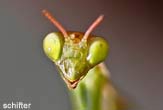Why Female Bugs Outsize Males

Men and women have got it reversed compared to most of the animal kingdom when it comes to the relative sizes of males and females.
For insects and spiders, as with most non-human animals, the majority of females outsize their male counterparts. A new study looks at why sexual dimorphism—the non-sexual size and shape differences between the sexes—exists in the world of six- and eight-legged creatures.
There are two routes to getting big, scientists say. Either the larger sex grows faster or it undergoes a longer period of growth.
Biologist Daphne Fairbairn of the University of California, Riverside, was one of 13 scientists who contributed research to determine which route prevailed among insects and spiders. The group looked at 155 species of creepy crawlies in which females are larger and found that the key is not how long it takes them to mature but the rate at which they grow.
“In the insects I research, females are larger than males. But it turns out they mature at the same age, and it takes the same amount of time to get to adult size,” she said. Females, then, must undergo more rapid growth.
So why are the males so much smaller?
“In most animals, the advantages of large size are apparent, whereas the disadvantages are not,” Fairbairn's colleague Wolf Blanckenhorn of the Zoological Museum at the University of Zurich told LiveScience.
Sign up for the Live Science daily newsletter now
Get the world’s most fascinating discoveries delivered straight to your inbox.
He proposes a theory to explain the advantages of small size: While females are bulking up, males are devoting their energy and resources to growing mature reproductive organs, which are much larger and more elaborate than in females—and relative to overall body size, are also significantly bigger than those of mammals.
While men are thought to grow big and strong to better compete for mates, insects and spiders might maximize their reproductive potential by staying small overall, Blanckenhorn explained. Growing larger "where it counts" gives males greater odds of inseminating their partner with each encounter.
The research is detailed in this month’s issue of The American Naturalist.
- Images: Backyard Bugs
- Creepy Spiders: The Best of Your Images
- More Oxygen Could Make Giant Bugs
- Smart Bats Have Smaller Testicles
- Spider Cries Out While Mating
- All About Insects









